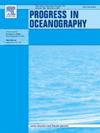南部夏季南大洋东印度板块大型浮游动物群落的时空变化:1996年与2018-2019年的比较
IF 3.6
3区 地球科学
Q1 OCEANOGRAPHY
引用次数: 0
摘要
几项大规模研究考察了南大洋东印度海域大型浮游动物群落的时空(季节和年际)变化。在本研究中,使用RMT8在KY1804调查期间收集的样本分析了这些群落的变异性,该调查于2018-2019年南方夏季在80°至150°E之间进行。此外,这些调查结果与1996年进行的BROKE调查结果进行了比较。通过聚类分析,将大型浮游动物群落划分为6个类群。在这两次调查中,浮游动物群落在采样区域的南站和北站之间有所不同,尽管它们的分布模式在两年内有所不同。在KY1804调查中,西部地区以Thysanoessa macrura多见,东部地区以Thysanoessa gaudichadii和chaetognath多见;在BROKE调查中,萨尔帕·汤普森在东部地区占主导地位。在KY1804调查中,水温对大型浮游动物群落的影响最大,而在BROKE调查中,盐度是主要的影响因素。这种差异可能在很大程度上反映了采样时间和纬度覆盖范围的差异,尽管两次调查之间南极环极流的南边界向南移动也可能有所贡献。1996年至2019年20年间的水文变化可能影响了该地区的大型浮游动物群落,尽管时空调查覆盖范围的差异使对结果的解释复杂化。本文章由计算机程序翻译,如有差异,请以英文原文为准。
Spatio-temporal changes in the macrozooplankton community in the eastern Indian sector of the Southern Ocean during austral summers: A comparison between 1996 and 2018–2019
Several large-scale studies have examined the spatial and temporal (seasonal and interannual) variability in macrozooplankton communities in the eastern Indian sector of the Southern Ocean. In this study, variability in these communities was analyzed using samples collected by the RMT8 during the KY1804 survey, conducted between 80° and 150° E during the austral summer of 2018–2019. Furthermore, these findings were compared with those of the BROKE survey conducted in 1996. Using cluster analysis, the macrozooplankton community was divided into six groups. In both surveys, the zooplankton communities varied between the southern and northern stations of the sampling areas, though their distribution patterns differed between the two years. During the KY1804 survey, Thysanoessa macrura was more prevalent in the western region, while Themisto gaudichaudii and chaetognaths were more abundant in the eastern region; Salpa thompsoni dominated in the eastern region during the BROKE survey. Water temperature had the strongest influence on the macrozooplankton community during the KY1804 survey, whereas salinity was the primary influencing factor during the BROKE survey. This difference may largely reflect differences in sampling timing and latitudinal coverage, though a southward shift in the southern boundary of the Antarctic Circumpolar Current between the surveys may also have contributed. Hydrographic changes over the two decades between 1996 and 2019 likely affected the macrozooplankton community in this region, though differences in spatial and temporal survey coverage complicate interpretation of the results.
求助全文
通过发布文献求助,成功后即可免费获取论文全文。
去求助
来源期刊

Progress in Oceanography
地学-海洋学
CiteScore
7.20
自引率
4.90%
发文量
138
审稿时长
3 months
期刊介绍:
Progress in Oceanography publishes the longer, more comprehensive papers that most oceanographers feel are necessary, on occasion, to do justice to their work. Contributions are generally either a review of an aspect of oceanography or a treatise on an expanding oceanographic subject. The articles cover the entire spectrum of disciplines within the science of oceanography. Occasionally volumes are devoted to collections of papers and conference proceedings of exceptional interest. Essential reading for all oceanographers.
 求助内容:
求助内容: 应助结果提醒方式:
应助结果提醒方式:


